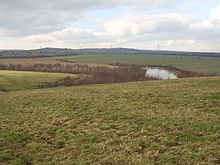Wharncliffe Woodmoor 1, 2 & 3 Colliery
The colliery was sunk in 1871 just after Joshua Willey, a Hoyland wine and spirit merchant, leased land from the Earl of Wharncliffe.
It received its modern name from the landowner, the Earl of Wharncliffe, and the Woodmoor seam of coal, first exploited in the 1870s.
Howard Allport became the new owner in 1881 and in 1883 converted the privately owned business into a limited liability concern and become known as the Wharncliffe Woodmoor Colliery Co. Ltd.
Seams worked were Haigh Moor, Barnsley, Kent's Thick, Winter, Lidgett and Beamshaw.
[5] In November 1965 it was announced by the National Coal Board that an accelerated pit closure programme would get under way affecting 120,000 men.
[7] The disaster at Wharncliffe Woodmoor colliery claimed fifty-eight lives and devastated the local community.
They brought news that they had dug through four walls, but that progress had been slow owing to the amount of debris which had to be cleared, and also to further slight falls.
E.F Owen Vicar of Staincross and Canon W.C Hudson of the Holy Rood Catholic Church, Barnsley offered the crowd spiritual comfort by conducting prayers in the pit yard.
The Mayor of Barnsley, Alderman Jones, was visiting Prague at the International Miners Conference with other council and mining officials at the time of the explosion, they had been cabled earlier that morning and informed by about 4:30 pm that afternoon.
The electrician had been instructed to make a general overhaul of the electrical apparatus in 1’s district which meant that he would remove the covers and examine the commutator and the starter of each unit.
The evidence seemed to point to the explosion being caused by a spark from the switch or the commutator of the loader motor but there was no absolute proof.
The new memorial was a more emotive piece of work that included the half pulley wheel, a stone frieze, sculptured by Harry Malkin, carved in brick supplied and fired by Ibstock brick company Nostell, Wakefield that depicts two miners searching for their lost colleagues and stands about ten feet by eight.
More than 100 people attended, including numerous relatives and descendants, some with Welsh origins, and representatives from the NUM.
There was minimal topsoil available on the site and after an initial flush of surface greening, the vegetation on the tip area partly failed due to acidification.
A joint project was launched with the National Urban Forestry Unit, Barnsley M.B.C, Yorkshire Water and Sludge Consultant to create a stable and self maintaining planting medium.
An estate of private houses has now been built adjacent to the reclaimed colliery waste tip, confirming the improvement of the area’s image.



